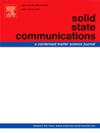Leveraging molecular dynamics and machine learning to predict impact performance in polycrystalline magnesium alloys
IF 2.1
4区 物理与天体物理
Q3 PHYSICS, CONDENSED MATTER
引用次数: 0
Abstract
There is currently a lack of research on the effects of grain spatial orientation distribution and shape characteristics on the mechanical properties of nanocrystalline magnesium alloys. To provide a means of studying such problems, this paper employs molecular dynamics simulations to construct a dataset that incorporates the spatial distribution and orientation features of grains within the model. Using 12 different machine learning methods, In this study predict the material's high-velocity impact response and analyze the predictive performance of various machine learning algorithms on this dataset. Additionally, through feature selection and segmented training sets, In this study demonstrate the capability of machine learning methods to perceive grain characteristics such as spatial distribution in this dataset. This validates the feasibility and effectiveness of applying machine learning methods to study such data. Furthermore, In this study offer recommendations for employing machine learning techniques in conjunction with datasets that include grain spatial distribution and orientation characteristics. By analyzing molecular dynamics datasets, In this study also predict the high-velocity impact response of over a thousand magnesium alloy compositions, shedding light on the mechanical properties of magnesium alloys under high-velocity impact.

利用分子动力学和机器学习来预测多晶镁合金的冲击性能
目前,有关晶粒空间取向分布和形状特征对纳米结晶镁合金机械性能影响的研究还很缺乏。为了提供研究此类问题的方法,本文采用分子动力学模拟来构建数据集,将晶粒的空间分布和取向特征纳入模型中。本研究使用 12 种不同的机器学习方法预测材料的高速冲击响应,并分析各种机器学习算法在该数据集上的预测性能。此外,通过特征选择和分段训练集,本研究还展示了机器学习方法感知晶粒特征(如数据集中的空间分布)的能力。这验证了应用机器学习方法研究此类数据的可行性和有效性。此外,本研究还为结合包含晶粒空间分布和取向特征的数据集使用机器学习技术提供了建议。通过分析分子动力学数据集,本研究还预测了一千多种镁合金成分的高速冲击响应,揭示了镁合金在高速冲击下的机械性能。
本文章由计算机程序翻译,如有差异,请以英文原文为准。
求助全文
约1分钟内获得全文
求助全文
来源期刊

Solid State Communications
物理-物理:凝聚态物理
CiteScore
3.40
自引率
4.80%
发文量
287
审稿时长
51 days
期刊介绍:
Solid State Communications is an international medium for the publication of short communications and original research articles on significant developments in condensed matter science, giving scientists immediate access to important, recently completed work. The journal publishes original experimental and theoretical research on the physical and chemical properties of solids and other condensed systems and also on their preparation. The submission of manuscripts reporting research on the basic physics of materials science and devices, as well as of state-of-the-art microstructures and nanostructures, is encouraged.
A coherent quantitative treatment emphasizing new physics is expected rather than a simple accumulation of experimental data. Consistent with these aims, the short communications should be kept concise and short, usually not longer than six printed pages. The number of figures and tables should also be kept to a minimum. Solid State Communications now also welcomes original research articles without length restrictions.
The Fast-Track section of Solid State Communications is the venue for very rapid publication of short communications on significant developments in condensed matter science. The goal is to offer the broad condensed matter community quick and immediate access to publish recently completed papers in research areas that are rapidly evolving and in which there are developments with great potential impact.
 求助内容:
求助内容: 应助结果提醒方式:
应助结果提醒方式:


